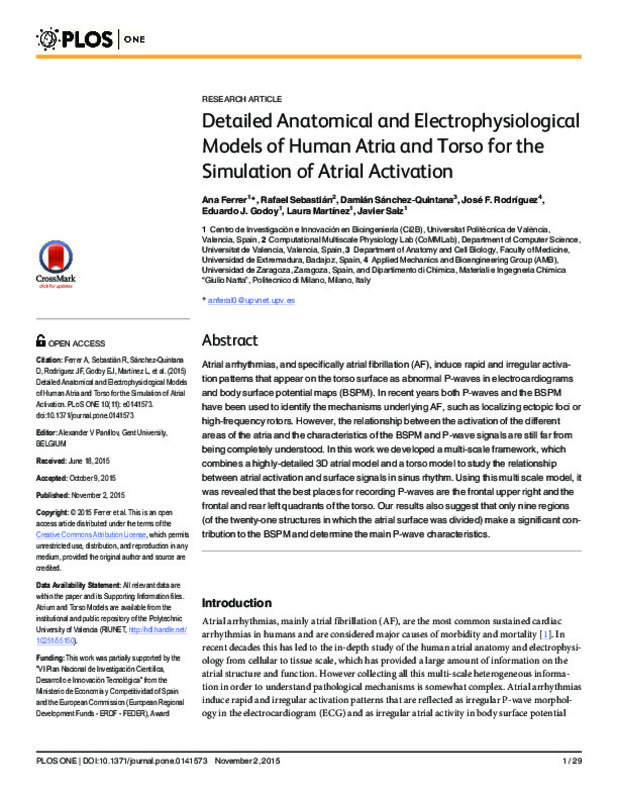JavaScript is disabled for your browser. Some features of this site may not work without it.
Buscar en RiuNet
Listar
Mi cuenta
Estadísticas
Ayuda RiuNet
Admin. UPV
Detailed Anatomical and Electrophysiological Models of Human Atria and Torso for the Simulation of Atrial Activation
Mostrar el registro sencillo del ítem
Ficheros en el ítem
| dc.contributor.author | Ferrer Albero, Ana
|
es_ES |
| dc.contributor.author | Sebastián Aguilar, Rafael
|
es_ES |
| dc.contributor.author | Sánchez Quintana, Damián
|
es_ES |
| dc.contributor.author | Rodriguez, José F.
|
es_ES |
| dc.contributor.author | Godoy, Eduardo Jorge
|
es_ES |
| dc.contributor.author | Martinez, Laura
|
es_ES |
| dc.contributor.author | Saiz Rodríguez, Francisco Javier
|
es_ES |
| dc.date.accessioned | 2016-05-26T12:55:09Z | |
| dc.date.available | 2016-05-26T12:55:09Z | |
| dc.date.issued | 2015-11-02 | |
| dc.identifier.issn | 1932-6203 | |
| dc.identifier.uri | http://hdl.handle.net/10251/64804 | |
| dc.description.abstract | Atrial arrhythmias, and specifically atrial fibrillation (AF), induce rapid and irregular activation patterns that appear on the torso surface as abnormal P-waves in electrocardiograms and body surface potential maps (BSPM). In recent years both P-waves and the BSPM have been used to identify the mechanisms underlying AF, such as localizing ectopic foci or high-frequency rotors. However, the relationship between the activation of the different areas of the atria and the characteristics of the BSPM and P-wave signals are still far from being completely understood. In this work we developed a multi-scale framework, which combines a highly-detailed 3D atrial model and a torso model to study the relationship between atrial activation and surface signals in sinus rhythm. Using this multi scale model, it was revealed that the best places for recording P-waves are the frontal upper right and the frontal and rear left quadrants of the torso. Our results also suggest that only nine regions (of the twenty-one structures in which the atrial surface was divided) make a significant contribution to the BSPM and determine the main P-wave characteristics. | es_ES |
| dc.description.sponsorship | This work was partially supported by the "VI Plan Nacional de Investigacion Cientifica, Desarrollo e Innovacion Tecnologica" from the Ministerio de Economia y Competitividad of Spain and the European Commission (European Regional Development Funds - ERDF - FEDER), Award Number: TIN2012-37546-C03-01 (Recipient: Ana Ferrer); the "Programa Estatal de Investigacion, Desarrollo e Innovacion Orientado a los Retos de la Sociedad" from the Ministerio de Economia y Competitividad and the European Commission (European Regional Development Funds - ERDF - FEDER), Award Number: TIN2014-59932-JIN (Recipient: Rafael Sebastion); and the "Programa Prometeo" from the Generalitat Valenciana, Award Number: 2012/030 (Recipient: Laura Martinez). | en_EN |
| dc.language | Inglés | es_ES |
| dc.publisher | Public Library of Science | es_ES |
| dc.relation | "VI Plan Nacional de Investigacion Cientifica, Desarrollo e Innovacion Tecnologica" from the Ministerio de Economia y Competitividad of Spain | es_ES |
| dc.relation | "Programa Estatal de Investigacion, Desarrollo e Innovacion Orientado a los Retos de la Sociedad" from the Ministerio de Economia y Competitividad | es_ES |
| dc.relation.ispartof | PLoS ONE | es_ES |
| dc.rights | Reserva de todos los derechos | es_ES |
| dc.subject | BODY-SURFACE | es_ES |
| dc.subject | P-WAVE | es_ES |
| dc.subject | CONDUCTION-VELOCITY | es_ES |
| dc.subject | SINUS RHYTHM | es_ES |
| dc.subject | ACTION-POTENTIALS | es_ES |
| dc.subject | VOLUME CONDUCTOR | es_ES |
| dc.subject | RATE-DEPENDENCE | es_ES |
| dc.subject | CANINE RIGHT | es_ES |
| dc.subject | HUMAN HEART | es_ES |
| dc.subject | FIBRILLATION | es_ES |
| dc.subject.classification | TECNOLOGIA ELECTRONICA | es_ES |
| dc.title | Detailed Anatomical and Electrophysiological Models of Human Atria and Torso for the Simulation of Atrial Activation | es_ES |
| dc.type | Artículo | es_ES |
| dc.identifier.doi | 10.1371/journal.pone.0141573 | |
| dc.relation.projectID | info:eu-repo/grantAgreement/MINECO//TIN2014-59932-JIN/ES/CARACTERIZACION Y DIAGNOSTICO NO INVASIVO DE ARRITMIAS CARDIACAS MEDIANTE MODELADO COMPUTACIONAL 3D ANATOMO-FUNCIONAL DEL CORAZON Y TORSO HUMANO/ | es_ES |
| dc.relation.projectID | info:eu-repo/grantAgreement/GVA//PROMETEO%2F2012%2F030/ES/MEJORA EN LA PREVENCION Y TRATAMIENTO DE PATOLOGIAS CARDIACAS A TRAVES DE LA MODELIZACION MULTI-ESCALA Y LA SIMULACION COMPUTACIONAL (DIGITAL HEART)/ | es_ES |
| dc.relation.projectID | info:eu-repo/grantAgreement/MINECO//TIN2012-37546-C03-01/ES/CORAZON HUMANO COMPLETO FISIOLOGICO VIRTUAL: MEJORAS EN EL TRATAMIENTO DE ARRITMIAS CARDIACAS ORIENTADO A PACIENTE/ | es_ES |
| dc.rights.accessRights | Abierto | es_ES |
| dc.contributor.affiliation | Universitat Politècnica de València. Instituto Interuniversitario de Investigación en Bioingeniería y Tecnología Orientada al Ser Humano - Institut Interuniversitari d'Investigació en Bioenginyeria i Tecnologia Orientada a l'Ésser Humà | es_ES |
| dc.contributor.affiliation | Universitat Politècnica de València. Departamento de Ingeniería Electrónica - Departament d'Enginyeria Electrònica | es_ES |
| dc.description.bibliographicCitation | Ferrer Albero, A.; Sebastián Aguilar, R.; Sánchez Quintana, D.; Rodriguez, JF.; Godoy, EJ.; Martinez, L.; Saiz Rodríguez, FJ. (2015). Detailed Anatomical and Electrophysiological Models of Human Atria and Torso for the Simulation of Atrial Activation. PLoS ONE. 10(11):1-29. https://doi.org/10.1371/journal.pone.0141573 | es_ES |
| dc.description.accrualMethod | S | es_ES |
| dc.relation.publisherversion | http://dx.doi.org/10.1371/journal.pone.0141573 | es_ES |
| dc.description.upvformatpinicio | 1 | es_ES |
| dc.description.upvformatpfin | 29 | es_ES |
| dc.type.version | info:eu-repo/semantics/publishedVersion | es_ES |
| dc.description.volume | 10 | es_ES |
| dc.description.issue | 11 | es_ES |
| dc.relation.senia | 297593 | es_ES |
| dc.identifier.pmid | 26523732 | en_EN |
| dc.identifier.pmcid | PMC4629897 | en_EN |
| dc.contributor.funder | Ministerio de Economía y Competitividad | es_ES |
| dc.contributor.funder | Generalitat Valenciana | es_ES |
| dc.contributor.funder | Ministerio de Ciencia e Innovación | es_ES |








